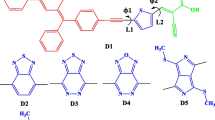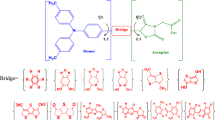Abstract
Dye-sensitized solar cells (DSSCs) have drawn great attention as low cost and high performance alternatives to conventional photovoltaic devices. The molecular design presented in this work is based on the use of pyran type dyes as donor based on frontier molecular orbitals (FMO) and theoretical UV-visible spectra in combination with squaraine type dyes as an acceptor. Density functional theory has been used to investigate several derivatives of pyran type dyes for a better dye design based on optimization of absorption, regeneration, and recombination processes in gas phase. The frontier molecular orbital (FMO) of the HOMO and LUMO energy levels plays an important role in the efficiency of DSSCs. These energies contribute to the generation of exciton, charge transfer, dissociation and exciton recombination. The computations of the geometries and electronic structures for the predicted dyes were performed using the B3LYP/6–31+G** level of theory. The FMO energies (EHOMO, ELUMO) of the studied dyes are calculated and analyzed in the terms of the UV- visible absorption spectra, which have been examined using time-dependent density functional theory (TD-DFT) techniques. This study examined absorption properties of pyran based on theoretical UV- visible absorption spectra, with comparisons between TD-DFT using B3LYP, PBE, and TPSSH functionals with 6–31+G (d) and 6–311++G** basis sets. The results provide a valuable guide for the design of donor-acceptor (D-A) dyes with high molar absorptivity and current conversion in DSSCs. The theoretical results indicated 4-(dicyanomethylene)-2-methyl-6-(p-dimethylaminostyryl)-4H-pyran dye (D2-Me) can be effectively used as a donor dye for DSSCs. This dye has a low energy gap by itself and a high energy gap with squaraine acceptor type dye, the design that reduces the recombination and improves the photocurrent generation in solar cell.







Similar content being viewed by others
References
Vlachopoulos N, Liska P, Augustynski J, Grätzel M (1988) Very efficient visible light energy harvesting and conversion by spectral sensitization of high surface area polycrystalline titanium dioxide films. J Am Chem Soc 110:1216–1260
O’Regan B, Grätzel M (1991) A low-cost, high-efficiency solar cell based on dye-sensitized colloidal titanium dioxide films. Nature 353:737–740
Smestad G, Bignozzi C, Argazzi R (2004) Testing of dye sensitized TiO2 solar cells I: experimental photocurrent output and conversion efficiencies. Sol Energy Mater Sol Cells 53:259–272
Hagfeldt A, Grätzel M (1995) Light-induced redox reactions in nanocrystalline systems. Chem Rev 95:49–68
Kay A, Grätzel M (1996) Low cost photovoltaic modules based on dye sensitized nanocrystalline titanium dioxide and carbon powder. Sol Energy Mater Sol Cells 44:99–117
Kalyanasundaram K, Grätzel M (1998) Applications of functionalized transition metal complexes in photonic and optoelectronic devices. Coord Chem Rev 177:347–414
Hagfeldt A, Grätzel M (2000) Molecular photovoltaics. Acc Chem Res 33:269–277
Grätzel M (2003) Dye-sensitized solar cells. J Photochem Photobiol C Photochem Rev 4:145–153
Nazeeruddin MK, De Angelis F, Fantacci S, Selloni A, Viscardi G, Liska P, Ito S, Takeru B, Grätzel M (2005) Combined experimental and DFT-TD-DFT computational study of photoelectrochemical cell ruthenium sensitizers. J Am Chem Soc 127:16835–16848
Kafafy H, Wu H, Peng M, Hu H, Yan K, El-Shishtawy R Mm, Zou D (2014) Steric and solvent effect in dye-sensitized solar cells utilizing phenothiazine-based dye. Int J Photoenergydoi:10.1155/2014/548914
Wang ZS, Hara K, Danoh Y, Kasada C, Shinpo A, Suga S, Arakawa H, Sugihara H (2005) Photophysical and (photo) electrochemical properties of a coumarin Dye. J Phys Chem B 109:3907–3914
Wang ZS, Cui Y, Hara K, Dan-oh Y, Kasada C, Shinpo A (2007) A high-light-harvesting-efficiency coumarin dye for stable dye-sensitized solar cells. Adv Mater 19:1138–1141
Alex S, Santhosh U, Das S, Papadodima O, Chatziioannou A, Patrinou-Georgoula M, Kolisis FN, Pletsa V, Guialis A (2005) Dye sensitization of nanocrystalline TiO2: enhanced efficiency of unsymmetrical versus symmetrical squaraine dyes. J Photochem Photobiol A 172:63–71
Burke A, Schmidt-Mende L, Ito S, Grätzel M (2007) A novel blue dye for near-IR “dye-sensitized” solar cell applications. Chem Commun 3:234–236
Howie WH, Claeyssens F, Miura H, Peter LM (2008) Characterization of solid-state dye-sensitized solar cells utilizing high absorption coefficient metal-free organic dyes. J Am Chem Soc 130:1367–1375
Horiuchi T, Miura H, Sumioka K, Uchida S (2004) High efficiency of dye-sensitized solar cells based on metal-free indoline dyes. J Am Chem Soc 126:12218–12219
Campbell WM, Burrell AK, Officer DL, Jolley KW (2004) Porphyrins as light harvesters in the dye-sensitized TiO2 solar cell. Coord Chem Rev 248:1363–1379
Chen Z, Li F, Huang C (2007) Organic D-π-A dyes for dye-sensitized solar cell. Curr Org Chem 11:1241–1258
Walsh PJ, Gordon KC, Officer DL, Campbell WM (2006) A DFT study of the optical properties of substituted Zn(II)TPP complexes. J Mol Struct (THEOCHEM) 759:17–24
Vyas S, Hadad CM, Modarelli DA (2008) A computational study of the ground and excited state structure and absorption spectra of free-base N-confused porphine and free-base N-confused tetraphenylporphyrin. J Phys Chem A 112:6533–6549
Balanay MP, Kim DH (2008) DFT/TD-DFT molecular design of porphyrin analogues for use in dye-sensitized solar cells. Phys Chem Chem Phys 10:5121–5127
Liu T, Zhang HX, Zhou X, Xia BH (2008) Theoretical studies on [Ru(bpy)2(NN)]2+ [NN = hydrazone and azine]: ground- and excited-state geometries, electronic structures, absorptions, and phosphorescence mechanisms. Eur J Inorg Chem 2008:1268–1276
Liu Z (2008) Theoretical studies of natural pigments relevant to dye-sensitized solar cells. J Mol Struct (THEOCHEM) 862:44–48
Balanay MP, Kim DH (2009) Structures and excitation energies of Zn–tetraarylporphyrin analogues: a theoretical study. J Mol Struct (THEOCHEM) 910:20–26
Minaev BF, Baryshnikov GV, Slepets AA (2012) Structure and spectral properties of triphenylamine dye functionalized with 3,4 propylenedioxy thiophene. Opt Spektrosk 112:899–905
Baryshnikov GV, Minaev BF, Myshenko EV, Minaeva VA (2013) Structure and electronic absorption spectra of isotruxene dyes for dye sensitized solar cells: investigation by the DFT, TD-DFT, and QTAIM methods. Opt Spektrosk 115:555–562
Baryshnikova GV, Minaeva BF, Minaeva VA, Ning Z, Zhang Q (2012) Structure and spectral properties of truxene dye S5. Opt Spektrosk 112:193–199
Minaev BF, Gleb VB, Minaeva VA (2011) Electronic structure and spectral properties of the triarylamine-dithienosilole dyes for efficient organic solar cells. Dyes Pigments 92:531–536
Marques MAL, Gross EKU (2004) Time-dependent density-functional theory. Annu Rev Phys Chem 55:427–455
Samuel GA, Jason P, Joshi P, Qiquan Q, Youngjae Y (2004) New pyran dyes for dye-sensitized solar cells. J Photochem Photobiol A Chem 224:116–122
Zhidan T, Yunchang L, Baozhu T, Jinlong Zh (2013) Synthesis and proton-induced fluorescence “OFF–ON” switching of a new D-p-A type pyran dye. Res Chem Intermed
Gerasimenkoa A Yu, Podgaetsky V M, Krasovsky V I, Lugovsky A P (2009) Optical Memory and Neural Networks. (Information Optics) 18:218–222
Cui Y, Jiancan Y, Gao J, Wang Z, Qian G (2009) Synthesis and luminescence behavior of inorganic–organic hybrid materials covalently bound with pyran-containing dyes. Sol gel Sci Technol 52:362–369
Kim JH, Lee H (2002) Synthesis, electrochemistry, and electroluminescence of novel red-emitting poly(p-phenylenevinylene) derivative with 2-pyran-4-ylidenemalononitrile obtained by the heck reaction. Chem Mater 14:2270–2275
Peng Q, Lu Z Y, Huang Y, Xie M G, Han S H, Peng J B, Cao Y (2004) Synthesis and characterization of new red-emitting polyfluorene derivatives containing electron-deficient 2-pyran-4-ylidene-malononitrile moieties, Macromolecules 260–266
Son YA, Gwon SY, Lee SY, Kim SH (2010) Synthesis and property of solvatochromic fluorophore based on D-pi-A molecular system: 2-{[3-Cyano-4-(N-ethyl-N-(2-hydroxyethyl)amino)styryl]-5,5-dimethylfuran-2(5H)-ylidene}malononitrile dye. Spectrochim Acta A Mol Biomol Spectrosc 75:225–229
Xue JLH, Gu X, Yang Z, Xu B, Tian W (2009) Efficient bulk-heterojunction solar cells based on a symmetrical D-pi-A-pi-D organic dye molecule. J Phys Chem C 113:12911–12917
Furche F, Burke K (2005) Time-dependent density functional theory in quantum chemistry. In: Spellmeyer A (ed) Annual reports in computational chemistry, vol 1. Elsevier, Amsterdam, pp 19–30
Burke K, Gross EKU (1998) A guided tour of time-dependent density functional theory. In: Joubert A (ed) Density functionals: theory and applications. Springer, Berlin
Gross EKU, Aobson JF, Petersilka M (1996) Density functional theory of time-dependent phenomena. Top Curr Chem 181:81–172
Luo Y, Jonsson D, Norman P, Ruud K, Vahtras O, Minaev B, Ågre H, Rizzo A, Mikkelsen KV (1998) Some recent developments of high-order response theory. Int J Quant Chem 70:219–239
Frisch M J, Trucks G W, Schlegel H B, Scuseria G E, Robb M A, Cheeseman J R, Montgomery J A, Jr, Vreven T, Kudin K N, Burant J C (2009) Gaussian 03; Gaussian Inc, Wallingford, CT
Lee C, Yang W, Parr RG (1988) Development of the Colle-Salvetti correlation-energy formula into a functional of the electron density. Phys Rev B 37:785–789
Becke AD (1993) Density-functional thermochemistry. III. The role of exact exchange. J Chem Phys 98:5648–5652
Perdew JP, Burke K, Ernzerhof M (1997) Generalized gradient approximation made simple. Phys Rev Lett 78:1396
Perdew JP, Burke K, Ernzerhof M (1996) Generalized gradient approximation made simple. Phys Rev Lett 77:3865–3868
Adamo C, Barone V (1999) Toward reliable density functional methods without adjustable parameters: the PBE0 model. J Chem Phys 110:6158–6170
Perdew JP, Tao J, Staroverov VN, Scuseria GEJ (2004) Chem Phys 120:6898–6911
Perdew JP, Kurth S, Zupan A, Blaha P (1999) Phys Rev Lett 82:2544–2547
Wu J, Hagelberg F, Dinadayalane TC, Leszczynska D, Leszczynski J (2011) Do stone–wales defects alter the magnetic and transport properties of single-walled carbon nanotubes? J Phys Chem C 115:22232–22241
Nueesch F, Zuppiroli L, Berner D, Ma C, Wang X, Cao Y, Zhang B (2004) Space charge and polarization effects upon doping organic light-emitting diodes with pyran-containing donor-acceptor molecules. Res Chem Intermed 30:495–507
Acknowledgments
This Project was funded by the King Abdulaziz City for Science and Technology (KACST) under grant number 11-ENE1531-03. The authors, therefore, acknowledge with thanks KACST for support for Scientific Research. Also, the authors appreciate the kind cooperation provided by the Deanship of Scientific Research (DSR), King Abdulaziz University.
Author information
Authors and Affiliations
Corresponding authors
Rights and permissions
About this article
Cite this article
El-Shishtawy, R.M., Asiri, A.M., Aziz, S.G. et al. Molecular design of donor-acceptor dyes for efficient dye-sensitized solar cells I: a DFT study. J Mol Model 20, 2241 (2014). https://doi.org/10.1007/s00894-014-2241-5
Received:
Accepted:
Published:
DOI: https://doi.org/10.1007/s00894-014-2241-5




